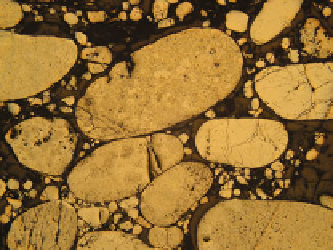Geology Reference
In-Depth Information
include sand or gravel banks on the interior of meanders, below rapids and falls,
downstream from boulders or other obstacles such as fractures, joints or ridges in
streambeds. In all of these locations, the less dense or finer particles are transported
away from the site of deposits by fast-flowing water leaving the denser or larger
grains in regions of reduced water velocity.
Gold in placer deposits is almost entirely in the metallic form and occurs in a
range of grain sizes, fromminute particles or flakes to large nuggets. Gold in placers
is very pure, normally 80-85% Au, the rest being mainly Ag. At locations where the
original lode source of placer gold can be identified, the placer gold is normally
purer than the lode gold. The refinement apparently takes place in part during
oxidation when the lode gold is exposed at the surface, because silver is more
soluble than gold under these conditions. However, fine layers of very pure gold
(98-99%) commonly forms rims around particles and nuggets of gold in placer
deposits, which leads to the hypothesis that the nuggets continue to grow within the
placers themselves by some sort of dissolution-precipitation process.
Quartz pebble conglomerate or pyritic paleoplacers
, of which the ore bodies in
the Witwatersrand Basin in South Africa are the type example, were deposited in
braided streams and alluvial fans during the Paleoproterozoic. The conglomerates
consist of well-rounded pebbles of quartz, chert and locally pyrite (Fig.
5.2
)ina
matrix of quartz, mica, chlorite, pyrite and fuchsite. They contain native gold, pyrite
and other sulfides, arsenides and sulfosalts, uraninite (UO
2
), brannerite (U
4+
,Ca)
(Ti,Fe
3+
)
2
O
6
, small nuggets of the platinum group elements and, significantly (for
reasons explained below) pyrobitumen. The native gold is located in the matrix of
the conglomerates and minor amounts of gold also occur in the pyrite and other
sulfur minerals. Two morphological types of gold can be distinguished, well-
rounded grains that resemble small nuggets in young placer deposits, and irregular
aggregates and well-crystallized euhedral overgrowths that resemble gold of hydro-
thermal origin.
Figure
5.1
, a sketch map of the Witwatersrand basin, shows the central disposi-
tion of the sands and conglomerates of the Central Rand and West Rand groups that
contain the auriferous conglomerate reefs. It also shows the overlying Ventersdorp
flood basalts, which protected the reefs from erosion; and the surrounding granites
and greenstones, which were the probable source of the gold. Sediments of the
Fig. 5.2 Photograph of
rounded grains of detrital
pyrite in Witwatersrand
conglomerates - evidence of
reducing conditions during
the formation of the deposits.
The field of view is 8 mm
(Photo A. Hofmann)

Search WWH ::

Custom Search